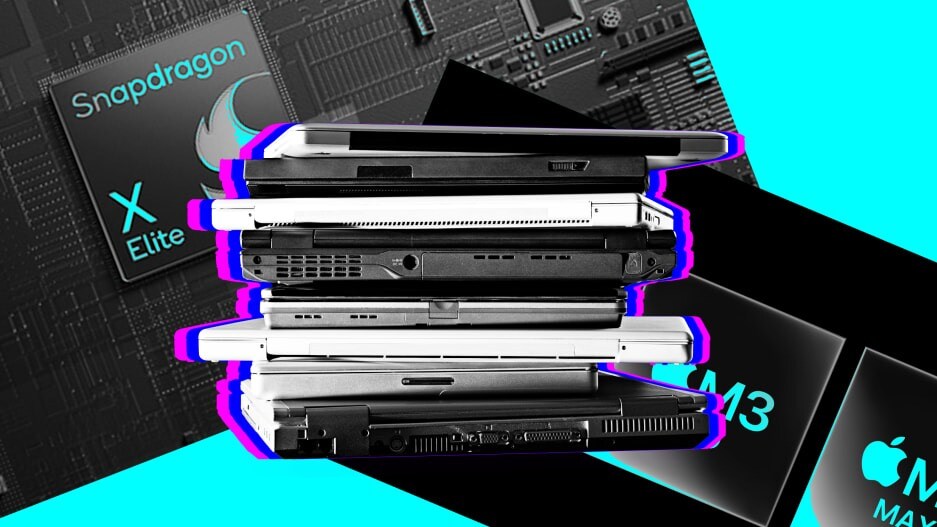- | 8:00 am
Why Mac vs. PC is about to get fun again
Apple’s and Qualcomm’s fast, AI-optimized chips could usher in an era of software innovation like we haven’t seen since the glory days of personal computing—or so I hope.

In mid-October, when I spoke with Qualcomm CEO Cristiano Amon about the company’s new Snapdragon X Elite chip, he told me it was the fastest laptop chip in history, with better performance than “anything Apple.” But the Snapdragon X Elite isn’t due to show up in Windows machines until mid-2024. And on Monday, when Apple unveiled three new chips of its own—the M3, M3 Pro, and M3 Max—it called them “the most advanced chips ever built for a personal computer.” They’ll be available in new MacBook Pro models shipping next week.
Until third-party experts have done their benchmarks, it may be premature to declare which company has the bragging rights to having designed the world’s leading laptop processor. Either way, the competition should be fun to watch. It might even make a decades-old question I haven’t thought about lately—Mac or PC?—more relevant than it’s been in years.
Actually, one of the nice things about both Windows PCs and Macs is that we don’t think about them all that much. Neither platform exudes coolness for its own sake: They’re quietly dependable when we need them and otherwise largely out of mind. You certainly don’t hear many people fretting over being addicted to their laptop or declaring it to be a “dystopian nightmare,” which is a nice change from some of the other technologies in our lives.
Still, as someone who spent a sizable percentage of my career working for computer magazines, I’ve found the largely unchanged state of desktop PCs and laptops in recent years oddly unsettling. As Bob Dylan said—and Steve Jobs liked to remind us—those who aren’t busy being born are busy dying.
In the case of Apple, the fact that a MacBook has pretty much remained a MacBook has been a conscious long-term decision. Since 2010, the company has used the iPad as its tapestry for rethinking the future of the personal computer. As makers of Windows PCs gave their portables touchscreens and fancy hinges that allowed for tablet-style usage, the MacBook (and its operating system, MacOS) offered consistency above all else. The Touch Bar—Apple’s ill-fated attempt to give Macs touch input without giving them a touchscreen—was an exception, but it never caught on and the company is probably relieved to have just discontinued the last Mac that offered it.
Meanwhile, Microsoft reacted to the iPad’s arrival with a radically reimagined operating system called Windows 8—and found that wide swaths of its customer base were not eager to enter its brave new world. Much of what was new in the subsequent Windows 10 and 11 involved backpedaling to a version of Windows that was more comfortably familiar.
Which raises a question: If the Mac and Windows experiences have reached seeming equilibrium, why do we need Apple’s and Qualcomm’s fast new chips? During Apple’s “Scary Fast” keynote video event on Monday, the company highlighted some of the uses that can benefit from the M3 chips’ speed, including 3D modeling, high-end video and audio editing, and gaming. If you’re the sort of person who can reasonably consider spending $7,200 for a fully tricked-out MacBook Pro with an M3 Max chip, you probably need all the computational muscle you can get right now.
And then there’s the rest of us. Your mileage may vary, but it’s been a long time since I last found my laptop to be unacceptably sluggish; more processing power isn’t all that alluring on its own. But I am excited about what AI might do for my computing experiences in the years to come. And if that AI runs right on a Mac or Windows PC—which will be a boon for privacy, real-time performance, and general integration into the apps I use—it will require processors the likes of which we haven’t seen until now.
I cheerfully admit that my excitement is anticipatory, since neither Apple nor Microsoft has built any jaw-dropping AI into their operating systems yet. (Windows 11’s Copilot is at best an intriguing first rough draft of what could be.) But without chips like Apple’s three M3 variants and Qualcomm’s Snapdragon X Elite—both of which are not only fast but also optimized for AI—operating systems would lack the hardware they need to do remarkable new things. Now that the silicon is arriving, the software will have the ability to take advantage of it. Nay, the responsibility.
What this will mean for Mac and Windows as experiences, I’m still not sure. But it could disrupt their recent history of nips, tucks, and incremental change rather than big new ideas. Apple and Microsoft, being such different companies, might even take entirely different approaches to seizing all the newfound power their machines are about to get. Rationally, I’m trying to remember to be careful what I wish for. On an emotional level, however, I say bring it on—and I hope that we have a better sense of what the future holds before 2024 is over.







































